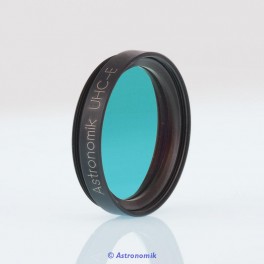 Ingrandisci
Ingrandisci Filtro Astronomik ASUHCE1 da 31.8mm
Astronomik
- Rimuovi questo prodotto dai miei preferiti
- Aggiungi questo prodotto ai miei preferiti.
- Stampa
Astronomik ASUHCE1 - UHC-E Filter 1.25 inch, mounted
 Ingrandisci
Ingrandisci Astronomik ASUHCE1 - UHC-E Filter 1.25 inch, mounted
Codice articolo: 8h00f0
The UHC-E filter is an ultra high contrast filter especially designed for the visual use with smaller telescopes
♦ Transmits Lines H-beta, [O III] and H-alpha, but also two brighter Swan Band lines at 511 nm and 514 nm
![Astronomik ASUHCE1 - UHC-E Filter 1.25 inch, mounted [EN] Astronomik ASUHCE1 - UHC-E Filter 1.25 inch, mounted [EN]](https://www.teleskop-express.it/img/cms/astronomik-uhce-31.8.jpg)
The Astronomik UHC-E filter is a budget filter for deep-sky observation of emission nebulae and comets under light polluted skies. It's particularly suitable for small 'scopes.
The UHC-E Filter increases contrast of emission nebulae and comets and blocks the light of typical streetlights as well as airglow. It is best suited for telescopes up to 5" / 125 mm.
Main use:
The Astronomik UHC-E filter provides a FWHM of 45 nm and blocks the light of typical streetlights (like sodium and mercury vapour) as well as airglow. Thus it increases contrast between your target and the night sky. The contrast enhancement is less than that of the Astronomik UHC filter, but at the same time the transmitted amount of starlight is greater. It´s therefore better suited to smaller telescopes.
As the UHC-E filter passes a spectral line of Carbon (due to the higher FWHM), it opens up the possibility of comet observation.
Other uses:
♦ Observation of Jupiter's clouds.
♦ Easier resolution of double stars.
♦ Photography under light-polluted skies with DSLRs and other cameras.
Alternatives:
If you use a telescope with an aperture larger than 5", we suggest the use of an Astronomik standard UHC filter because of its greater contrast enhancement capabilities. If you use a telescope larger than 8", you can try the Astronomik [O III] filter for even better results when observing specific nebulae.
Suitability:
♦ Visual observation (dark skies): Reasonable, an UHC filter is more suitable
♦ Visual observation (urban skies): Good, for telescopes up to 125 mm aperture and medium exit pupil
♦ Film photography: Good, but very long exposure times
♦ CCD photography: Good, when used with an additional IR blocking filter
♦ DSLR photography (original): Good, colour balance is near perfect
♦ DSLR photography (astro modified): Good, colour balance is near perfect
♦ DSLR photography (MC modified): Good, when used with an additional IR blocking filter
♦ Webcam / Video (Planets): Unsuitable
♦ Webcam / Video (Deep Sky): Very good, if light pollution is a big problem
Transmission curve:
![Astronomik ASUHCE1 - UHC-E Filter 1.25 inch, mounted [EN] Astronomik ASUHCE1 - UHC-E Filter 1.25 inch, mounted [EN]](https://www.teleskop-express.it/img/cms/astronomik-uhce-kurve.jpg)
♦ The horizontal axis is the wavelength in nanometers (nm). 400 nm is deep blue, at 520 nm the human eye senses green and at 600 nm red. At 656 nm is the famous "H-Alpha" emission line of hydrogen.
♦ The transmission in % is plotted on the vertical axis.
♦ The red line shows the transmission of the filter.
♦ Visual filters: The grey line in the background shows the relative sensitivity of the human eye at night. The maximum is at ~510 nm and drops to longer and shorter wavelengths. You can easily see, that you can´t see anything of the H-alpha line at night (even if you can during daylight!) The sensitivity at 656 nm is 0% at night!
♦ Photographic filters: The grey line in the background shows the sensitivity of a typical CCD sensor.
♦ The most important artifical emission lines are shown in orange. The artifical light pollution is dominated by see mercury (Hg) and sodium (Na), which are used in nearly all streetlights.
♦ The most important emission lines from nebulas are shown in green. The most important lines are from ionized hydrogen (H-alpha and H-beta) and double ionized oyxgen ([O III]). The square brackets show that these lines are forbidden.
